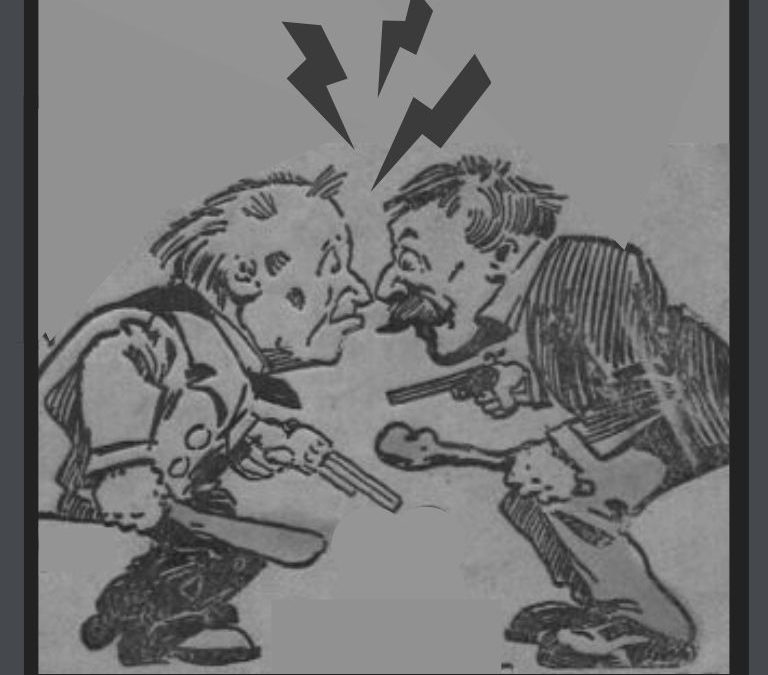
by Jo-Anne Peck | Jan 10, 2023 | Features
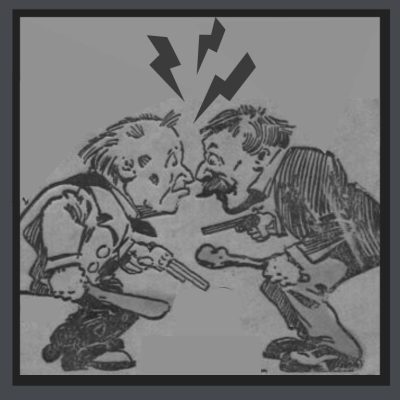 There are a lot of styles with crossover elements that can make them confusing to classify (and sometimes make architectural historians argue). Craftsman (1905-1930) and Tudor Revival (1890-1940) are two house styles that were popular around the same time period in the U.S., and you see elements of each in many homes since both styles “express the structure” in their design.
There are a lot of styles with crossover elements that can make them confusing to classify (and sometimes make architectural historians argue). Craftsman (1905-1930) and Tudor Revival (1890-1940) are two house styles that were popular around the same time period in the U.S., and you see elements of each in many homes since both styles “express the structure” in their design.
The most common crossover design element creating a Tudor/ Craftsman house connection is half-timbering, which is the exposed structure found in historic Tudor homes in Great Britain. This design element it can be found on many Craftsman style homes, although often as a faux version rather than actual structural components. Craftsman elements like brackets and wide eaves can also find their way into Tudor Revival homes. When classifying one or the other, the immediately noticeable difference is in the roof slope: Tudor Revival homes have a steep roof pitch while Craftsman homes have a lower roof pitch. Another distinction is that Craftsman homes have wide eaves and Tudor Revival commonly have little to no eave overhang. You can see some examples of Craftsman details here.
SOME EXAMPLES OF THE TUDOR CRAFTSMAN HOUSE CONNECTION
Below are some images of homes with both Craftsman and Tudor elements, each with a description below:

Craftsman bungalow with half timbering in the porch gable.
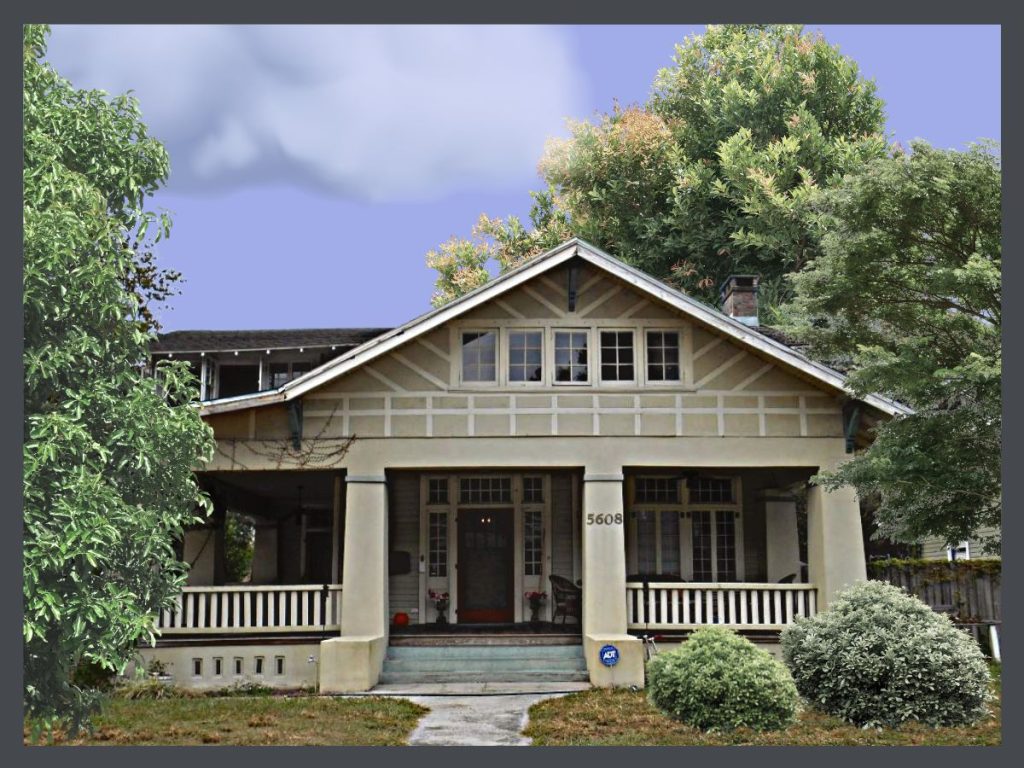
The half timbering in this gable end is a strong character defining feature of this Craftsman bungalow.

Craftsman bungalow with Tudor influenced gable ornament. This one has a steeper roof than many Craftsman homes, but I would still classify it as more Craftsman than Tudor Revival with wide eaves supported by eave brackets and beefy square columns.
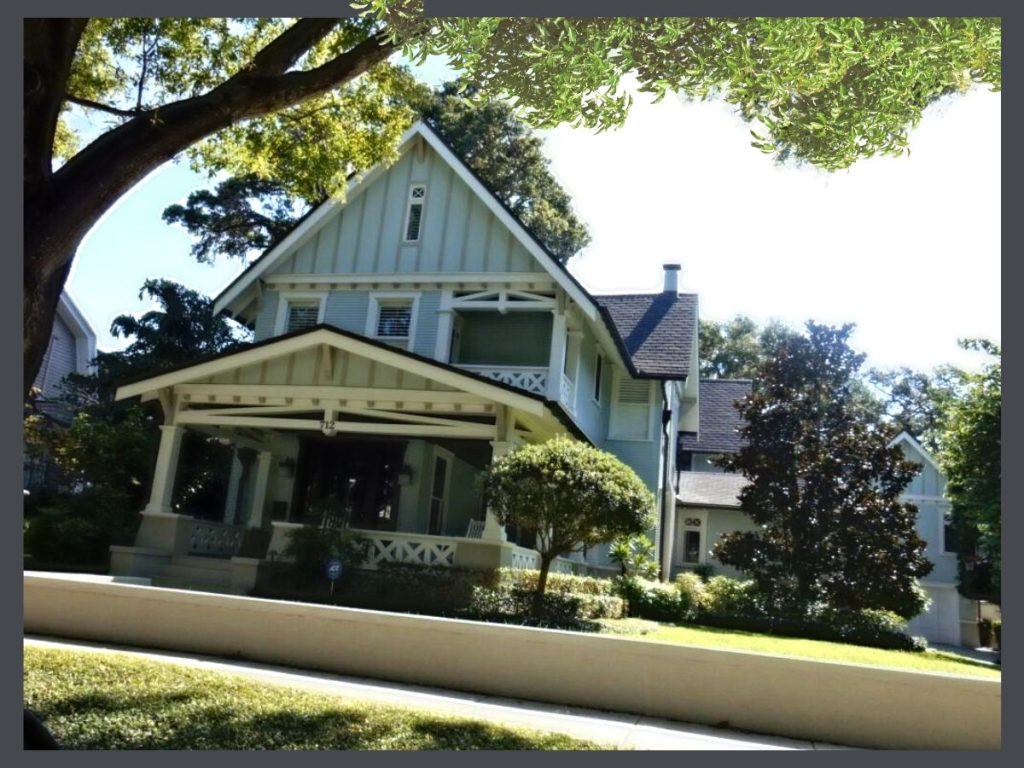
Tudor Revival home (note the steep main roof) with Craftsman style eave brackets and wide overhangs. I apologize for the wonky photo – just pretend I was being artsy and not clutzy.
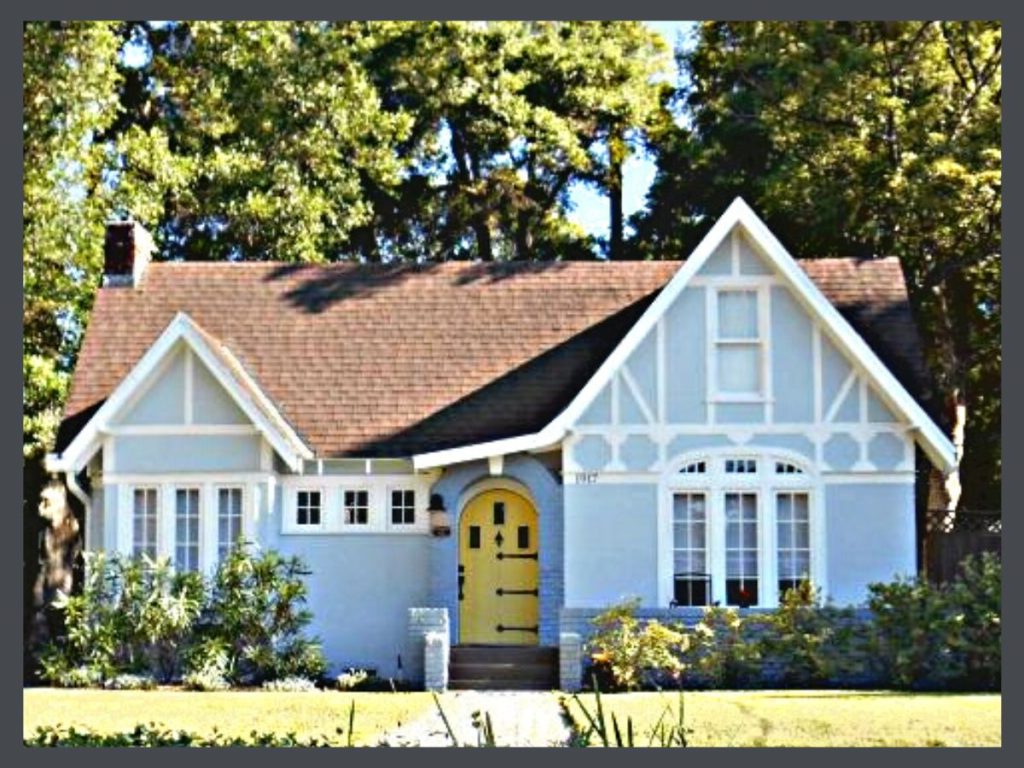
This little gem is a wonderful example of Tudor Revival with half timbering, but also has wider eaves than many of the style, with outriggers to support them.

 This article was written by Jo-Anne Peck of Preservation Resource, Inc. & Historic Shed. Jo-Anne is a historic preservation professional with a degree in Building Science, a Master’s of Fine Arts in Historic Preservation & a licensed Florida Building Contractor with over 25 years experience in preservation. She has kindly provided these photos & this information based her vast knowledge of bungalows.
This article was written by Jo-Anne Peck of Preservation Resource, Inc. & Historic Shed. Jo-Anne is a historic preservation professional with a degree in Building Science, a Master’s of Fine Arts in Historic Preservation & a licensed Florida Building Contractor with over 25 years experience in preservation. She has kindly provided these photos & this information based her vast knowledge of bungalows.
 STAY IN THE BUNGALOW KNOW!!! Sign up for our newsletter & receive our FREE E-book, 7 VITAL Things to Do Before You Hire a Contractor.
STAY IN THE BUNGALOW KNOW!!! Sign up for our newsletter & receive our FREE E-book, 7 VITAL Things to Do Before You Hire a Contractor.
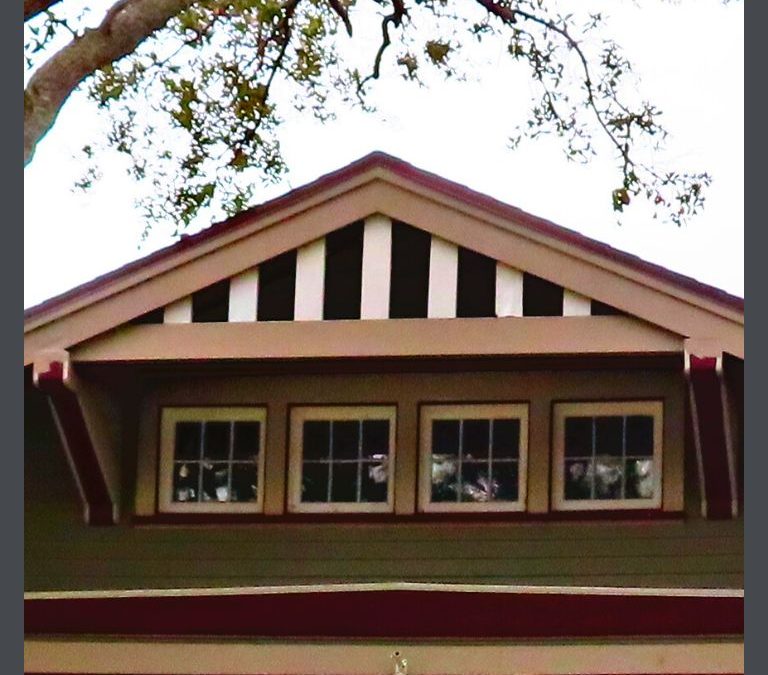
by bungalow101 | Dec 29, 2022 | Features
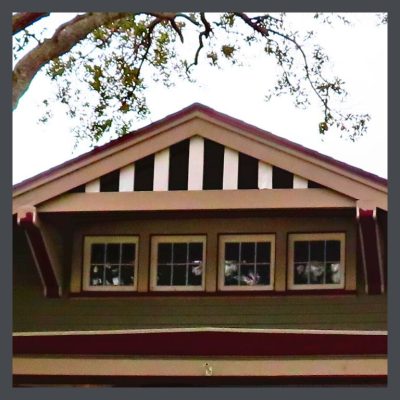 Let’s break down some bungalow characteristics to better understand what makes a bungalow, a bungalow. Character defining features, as further explained in the Secretary of the Interior’s Standards for Historic Preservation Projects is a term that means the way the visual & material aspects of a particular house style that set it apart from other styles.
Let’s break down some bungalow characteristics to better understand what makes a bungalow, a bungalow. Character defining features, as further explained in the Secretary of the Interior’s Standards for Historic Preservation Projects is a term that means the way the visual & material aspects of a particular house style that set it apart from other styles.
My friend Jo-Anne Peck, of Preservation Resource, Inc., & Historic Shed, is a historic preservation professional with a degree in Building Science, a Master’s of Fine Arts in Historic Preservation & licensed Florida Building Contractor with over 25 years experience in preservation. She has kindly provided these photos & this information based her her vast knowledge of bungalow preservation. They are grouped according to how they appeared on Facebook & I will add more from her every month, in a new part.
I am creating this page so that when I am asked, “What is a bungalow?” I’ll be able to point to these pages & after a bit, you’ll just know.
The links are to our glossary of exterior bungalow terms. Please follow it if you see a term that might be unfamiliar to you.
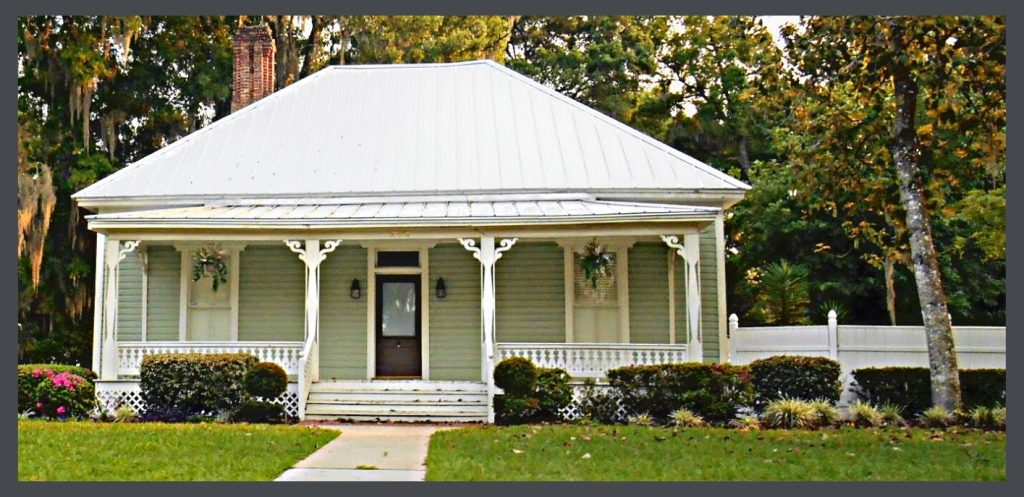
DESCRIPTION OF CHARACTERISTICS:
When someone says bungalow, we often first think of Craftsman style bungalows, but in reality, the term bungalow refers to the form of a house, not the style. Here is a Folk Victorian style bungalow with a hipped roof. I have to admit that I am partial to designs with a simple symmetry.
Here you can see some images of a more typical Folk Victorian.
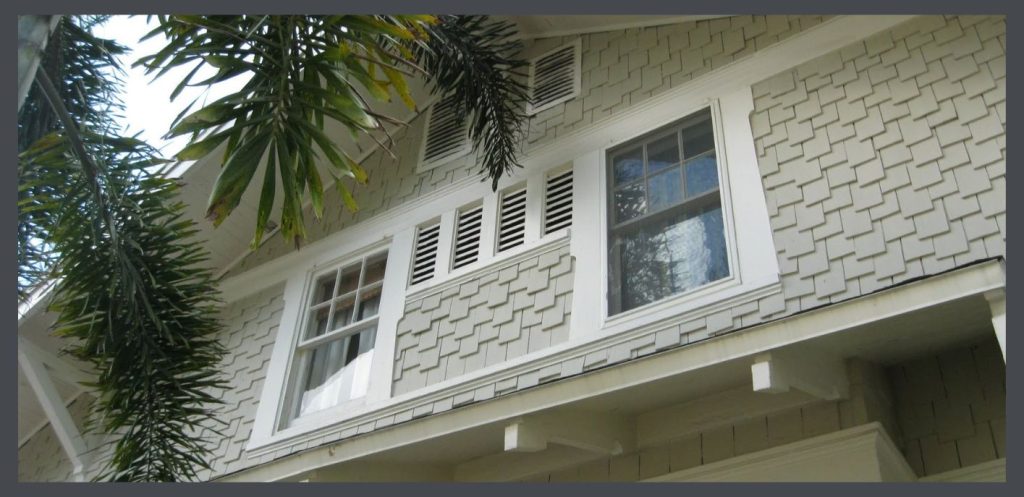
DESCRIPTION OF CHARACTERISTICS:
Texture, rhythm, and details. I love how the trim surrounding the windows flares differently on each side of the casing to accommodate the 4 vents. And look at the great cut rafter tails! This house was built by a craftsman skilled at their trade.
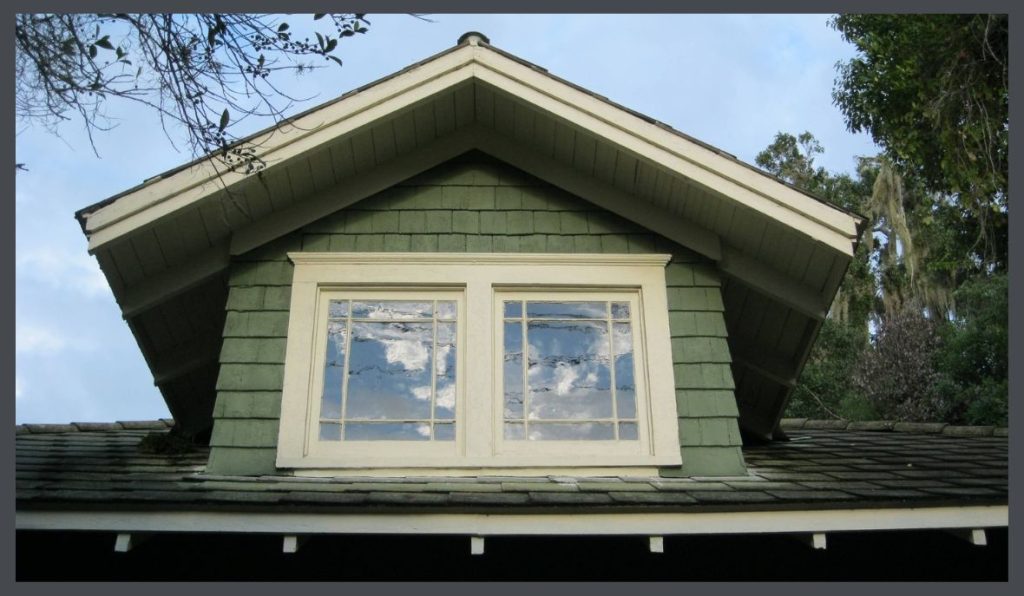
DESCRIPTION OF CHARACTERISTICS:
A gable dormer with shingle siding and divided lites with wavy glass. What more needs to be said?
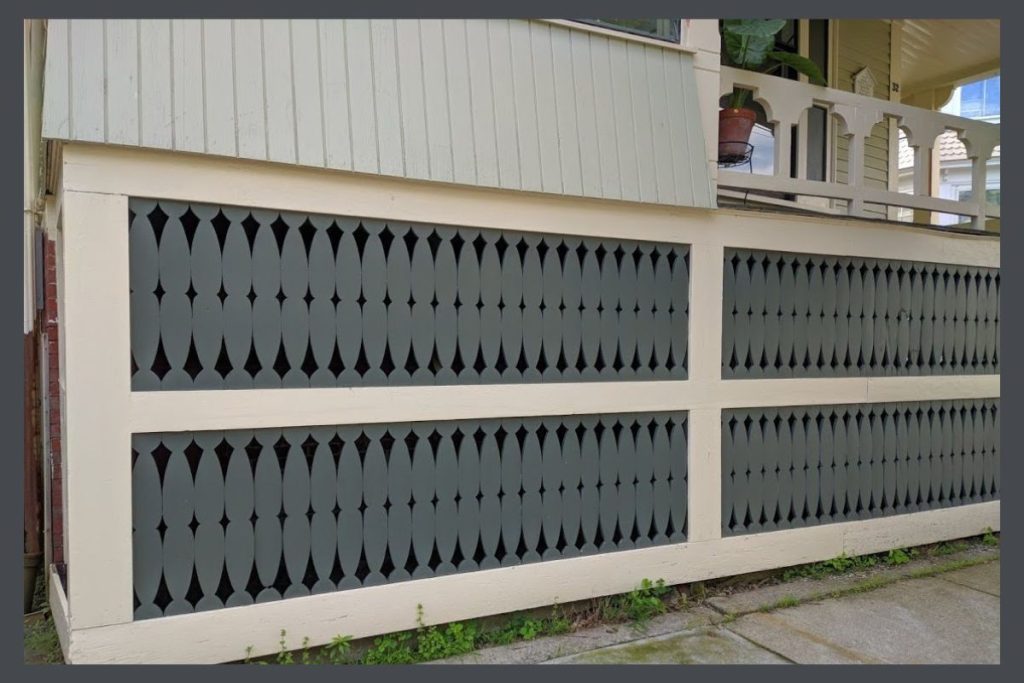
DESCRIPTION OF CHARACTERISTICS:
I know it’s a bit abnormal to get excited over foundation lattice, but I love when something so utilitarian and mundane is a design feature worthy of attention on its own. It’s a far cry from bright white plastic lattice, isn’t it?

DESCRIPTION OF CHARACTERISTICS:
One of the most common Craftsman bungalow forms is the front facing gable house with a separate, front facing gable porch. The porch is often 1/3, 1/2, or 2/3 the width of the house. Or, as in the case of this structure, the porch wraps around the side of the house, making the porch roof nearly the same width of the house front gable, but still providing a separate roofline.
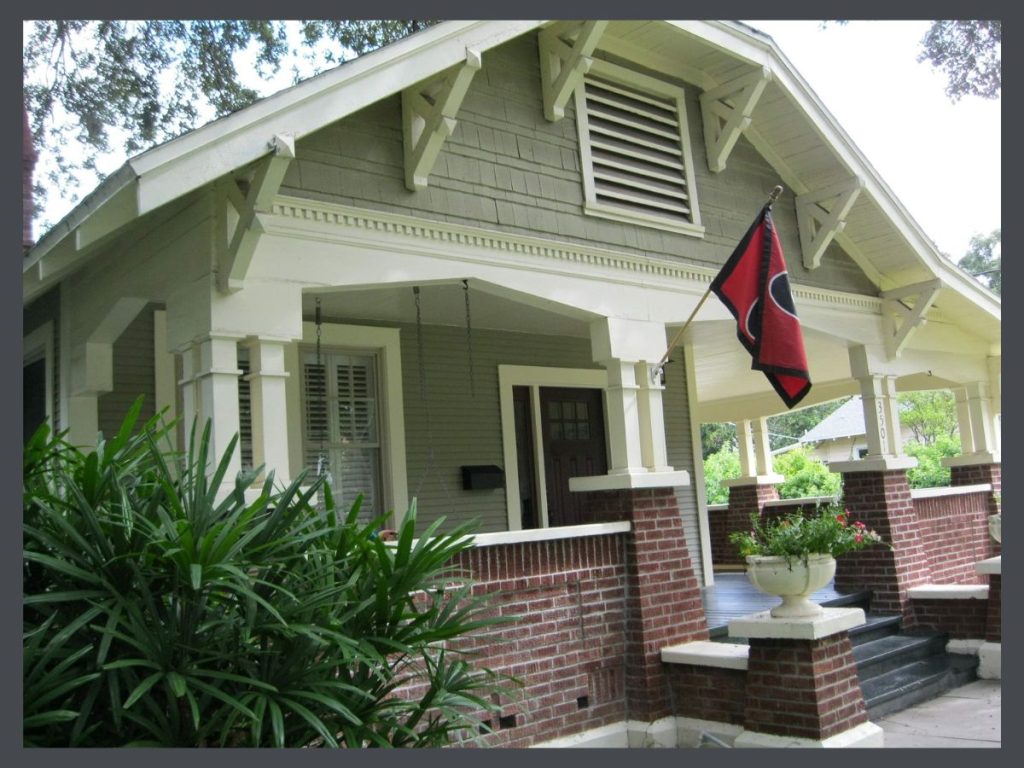
DESCRIPTION OF CHARACTERISTICS:
Some homes are so rich in detail that you just have to stop and take a photo!
This house in Tampa, FL has a lot going on from the jerkinhead roofline, to the surplus of eave brackets, porch dentil trim, paired and triple columns on sturdy tapered brick piers, shingled gable, and so much more …
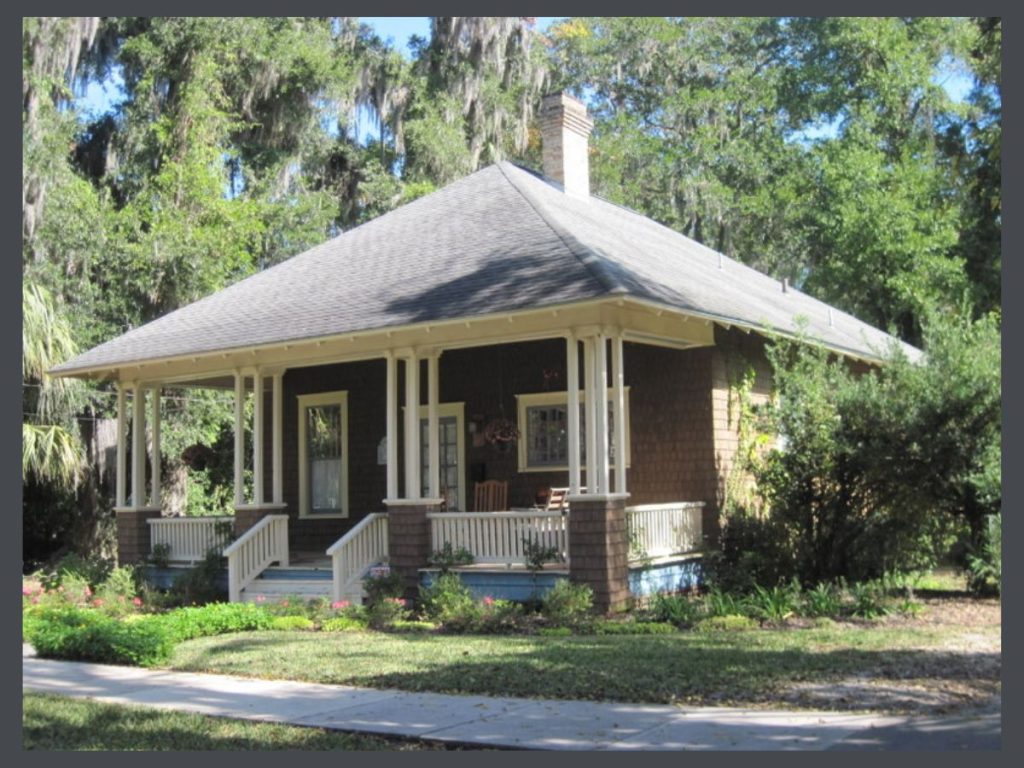
DESCRIPTION OF CHARACTERISTICS:
This bungalow has what is referred to as an integral porch, which means the roof is continuous over both the house and porch. It creates a clean, unfussy look and has no pesky transitions that can often be sources of potential leaks down the road. Shingle siding, exposed rafter tails and groups of 4 slender posts supporting the porch make for a lovely home.
 STAY IN THE BUNGALOW KNOW!!!
STAY IN THE BUNGALOW KNOW!!!
Sign up for our newsletter & receive our FREE E-book, 7 VITAL Things to Do Before You Hire a Contractor.
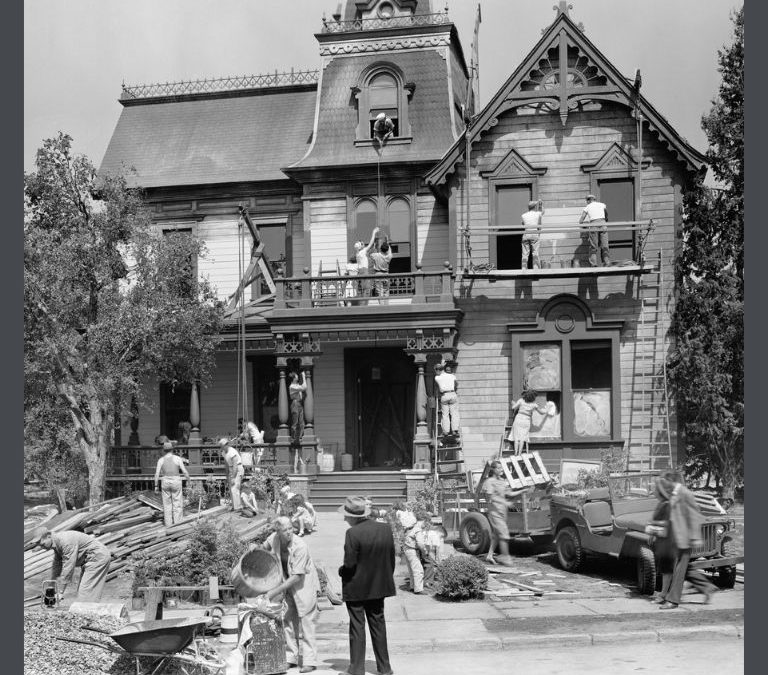
by bungalow101 | Dec 27, 2022 | Doors & windows, The History
 From their framing to their siding to their doors & windows to their built-ins & their flooring, our old houses, are built of old growth wood. Thousands of board feet of it.
From their framing to their siding to their doors & windows to their built-ins & their flooring, our old houses, are built of old growth wood. Thousands of board feet of it.
“Old growth.” What does that mean?
Let’s have a tree history lesson. Fossils show that the first tree-like plants, with vascular systems that transported water & nutrients, allowing the plants for the first time to rise up off the ground (Think moss.) & to form trunks & branches, developed 400 million years ago. Their evolution since then included the development of seeds & true woody stems.
Then,
Over 300 million years ago: The earliest conifers (i.e., cedar, fir, pine, redwoods & others) appear.
67 million years ago: Evidence of the first maple trees.
56 million years ago: Evidence of the first oak trees.
They continued to evolve & to create the great forests that covered most of America, generation after generation contributing to the next as they produced seeds, died & decayed, becoming part of the rich soil of the virgin woodland.
REDWOODS- THE LONGEST LIVING OF OLD GROWTH WOOD
 Let’s start with the Redwood, one class being the oldest plants on earth, living from about 800 to 3,200 years. On the west coast, before they were chopped to build our houses, they played an important part in the lives of early indigenous peoples who revered them, building structures from fallen trees. Native elder Minnie Reeves called them “a special gift from the Great Creator. Destroy these trees and you destroy the Creator’s love . . . and you will eventually destroy mankind.”
Let’s start with the Redwood, one class being the oldest plants on earth, living from about 800 to 3,200 years. On the west coast, before they were chopped to build our houses, they played an important part in the lives of early indigenous peoples who revered them, building structures from fallen trees. Native elder Minnie Reeves called them “a special gift from the Great Creator. Destroy these trees and you destroy the Creator’s love . . . and you will eventually destroy mankind.”
When California became a state in 1850, there were nearly 2 million acres of redwood forest. San Francisco was built twice with redwood, before & after the quake & fire of 1906. But the worst was yet to come. During the first half of the 20th Century when California experienced a major building boom, the redwood forest suffered its greatest losses, with trains of lumber heading south as trains of oranges headed north.
Going into the 21st Century, only 5 percent of the old growth forest still stood, thankfully protected on public lands.
In modern times, redwood farms produce wood for lumber, however, this new wood does not have the same high levels of toxic tannins, a type of bitter, astringent chemical compounds which protect the trees from fungus & insects & decrease its susceptibility to rot.
Selective cutting of young trees is permitted on redwood farms but these trees do not have enough age on them to acquire the decay & insect resistant properties of the old growth. If you want the original, old growth wood, you must buy it second-hand, salvaged from old buildings that some uninformed person has chosen to demolish.
OTHER OLD GROWTH CONIFERS IN OLD HOUSES
The Douglas fir forests of the Northwest were treated just as casually. The timber industry, both logging & milling’ developed into a huge industry. The quantities were regarded as unlimited, if they were regarded at all in the push to maximize profit. As harvesting & transportation technologies developed, so did the quantity of forest land destruction increase.
It wasn’t until the 1880’s that conservation of timber supplies was considered. National forests were established & research into good forest practices began.
OAK
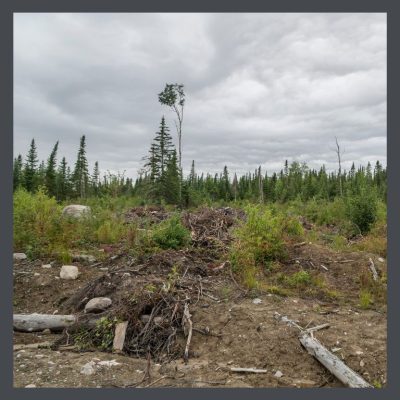 The Domesday Book of 1086, a survey ordered by William the Conqueror to record his holdings, indicated a forest cover of 15%, By the start of the next millennium, this coverage had dropped to 5%.
The Domesday Book of 1086, a survey ordered by William the Conqueror to record his holdings, indicated a forest cover of 15%, By the start of the next millennium, this coverage had dropped to 5%.
In the 17th Century, as thousands of colonists arrived in the United States from England, they placed heavy demands on the forests taking huge trees, some hundreds of years old, of many species for lumber not only for building but also for fuel. Additionally, they cleared lands for agriculture & livestock.
Additionally, after the Industrial Revolution, potash, potassium carbonate derived from burned wood was in high demand in the colonies & in England where they had already decimated their forests. By the early 1800’s, the pre-revolutionary American colonies were providing England with more than 60% of its potash.
The construction boom after WW I, especially during the mid-1920’s, furthered reduced our forest resources. You can read about pine’s story, in the forests of the Eastern U.S., here.
FARMED WOOD VS OLD-GROWTH WOOD
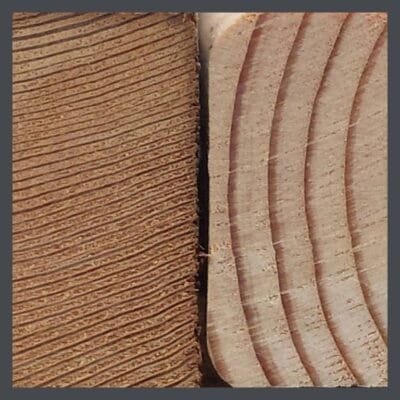 Trees are planted in man-made forests with the purpose of generating a large amount of product, fast. These farms do not replicate the ecology of the natural forest. Generally they are one species only, & all the trees are planted at the same time. The trees are planted in rows spaced to allow maximum sunlight & water exposure so they grow very fast. The old forests allowed trees to grow slowly, putting on more tightly-packed growth rings
Trees are planted in man-made forests with the purpose of generating a large amount of product, fast. These farms do not replicate the ecology of the natural forest. Generally they are one species only, & all the trees are planted at the same time. The trees are planted in rows spaced to allow maximum sunlight & water exposure so they grow very fast. The old forests allowed trees to grow slowly, putting on more tightly-packed growth rings
Because of this, new growth wood does not have the strength, stability nor the decay & insect repelling properties of old growth wood- not to mention the beauty. But. stick with me here. I have a theory about additional environmental factors that made the virgin forests a much better place for trees.
The conditions in the old forests had evolved over millions of years. Co-evolution is the evolving of all the parts of an ecosystem to assist each of its parts survive better. i.e., evolutionary change over time, benefiting each interacting member, usually involving different species. Tree farms lack this dynamic. They are the new kids in school without a support system, not oriented to their environment, & growing in unnatural conditions.
The virgin forest is home to many tree species as well as hundreds of different insects, animals & microbes. All of these organisms have made reciprocal adaptive changes in cooperation with one or more other species, over the millennia, helping one another to survive with greater & greater efficiency.
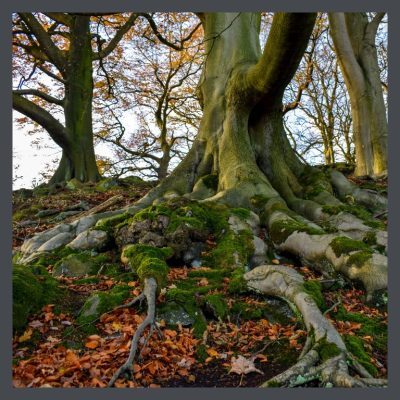 Much of this mutual adaptation involves microorganisms, the fungi that break down the fiber of the dead trees & turn them into nutritious soil, but also form a communication network for the trees. Watch this short video by National Geographic that explains how trees connect & share with one another.
Much of this mutual adaptation involves microorganisms, the fungi that break down the fiber of the dead trees & turn them into nutritious soil, but also form a communication network for the trees. Watch this short video by National Geographic that explains how trees connect & share with one another.
Trees do not stand alone, competing with one another for sunlight, water & nutrients. Rather, the forest is almost like a single organism, the different trees interacting with one another, both within & outside their own species, through their roots & the fungal networks that connect these roots. They exchange communication & nutrients through this network, with the larger, old Mother trees forming the hubs. As an example, Douglas firs share excess sugars with the leafless birches in the spring & fall, & in return, the birches send sugars to the Douglas-firs in the summer, via the fungi underground.
Here’s my crazy theory. The health of the human body depends on the quantity & diversity of the microbes that live in the gut. To build a strong, healthy body, one needs a strong healthy microbiome- the colony of microorganisms within the body. This is a lovely short video of 2 Stanford researchers who have discovered much of what is known in this science. They have a big picture of bacteria over the fireplace in their home.
My hypothesis is that lumber from a tree grown in the virgin forest is better, stronger, more stable, more decay & insect resistant not just because it is old & bigger, but because it has grown up with a Mother, a family, neighbors & friends in the form of an active ecosystem that has had millions of years to get it right. “It’s not better because it’s old, it’s old because it’s better.”
What do you think?
FOR MORE INFORMATION ON OLD GROWTH WOOD, VISIT OUR OLD HOUSE RESTORATION VIDEOS- OLD GROWTH WOOD here.
 STAY IN THE BUNGALOW KNOW!!!
STAY IN THE BUNGALOW KNOW!!!
Sign up for our newsletter & receive our FREE E-book, 7 VITAL Things to Do Before You Hire a Contractor.

by bungalow101 | Dec 26, 2022 | Doing it the right way, Features
 The story begins with my love affair with the Alfred W. & Grace D. Hare House, a beautiful Craftsman, in Eagle Rock, a bungalow neighborhood in N.E. Los Angeles. Once an incorporated town in its own right, Eagle Rock is just west of Pasadena & was clearly influenced by the architecture being built there.
The story begins with my love affair with the Alfred W. & Grace D. Hare House, a beautiful Craftsman, in Eagle Rock, a bungalow neighborhood in N.E. Los Angeles. Once an incorporated town in its own right, Eagle Rock is just west of Pasadena & was clearly influenced by the architecture being built there.
The entrance to the property is through an arbor that I had built with saplings that were so green that leaves kept growing long after the fence was constructed. An arroyo rock border lined the sidewalk & roses grew intertwined through the sapling fence. There’s a great, full page image of the arbor in BUNGALOW DETAILS: Exterior, on page 190
The rocks came from the nearby Arroyo Seco (which in Spanish means “dry gulch”) a canyon between Eagle Rock & Pasadena. This rock is a common material seen in houses in this area & clearly shows their place in the world.
My next-door-neighbor retired & got herself a chainsaw, Every time I heard the buzzing start-up, I’d grab my keys & head for the nursery to buy another tree. I ended up with a small grove of birches in the front & a shaggy, grafted tree that looked like a parasol under which fairies could dance, when it was first installed but turned into Cousin Itt as it grew. The house is on 1 1/2 lots & is set well back from the street, so the Addams family representative, the huge, aged pine & the new birches made a nice little forest.
MY ARTS & CRAFTS GARDEN
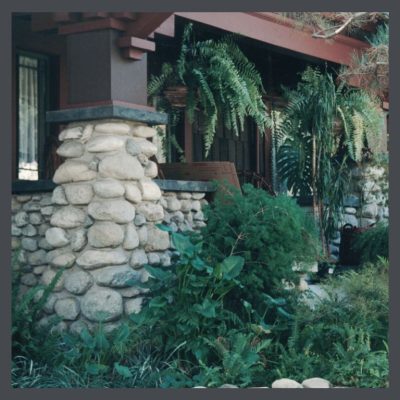 I also used the same rocks to form a path from the driveway to the front walk. I installed baby’s tears (Soleirolia soleirolii) a mossy appearing tropical perennial with tiny, tiny leaves between the path & the border. They were very soft & sweet & I coaxed them to grow so that they would provide a natural woodland look. A week before my mother was supposed to arrive to see the house for the first time, my gardener edged them so they were level on top & flat against the border. I am a plant whisperer but I admit that during that week I was more of a plant cheerleader & probably even a plant sergeant, alternating cheering & commanding them to grow back into gentle, fluffy mounds before my mom’s arrival.
I also used the same rocks to form a path from the driveway to the front walk. I installed baby’s tears (Soleirolia soleirolii) a mossy appearing tropical perennial with tiny, tiny leaves between the path & the border. They were very soft & sweet & I coaxed them to grow so that they would provide a natural woodland look. A week before my mother was supposed to arrive to see the house for the first time, my gardener edged them so they were level on top & flat against the border. I am a plant whisperer but I admit that during that week I was more of a plant cheerleader & probably even a plant sergeant, alternating cheering & commanding them to grow back into gentle, fluffy mounds before my mom’s arrival.
Inspired by the origins of the Arts & Crafts Movement, I planted an English garden. Arroyo rock bordered the garden beds which I enlarged & planted with shade loving plants on the shady side & plants that looked like shade loving plants on the other side. It was very difficult! Los Angeles is not England. Los Angeles is a desert & plants easily fry in the sun, so I had to stretch my wits to fill a bed that got nuked every day with plants that could have maybe been in an English cottage garden.
A great deal of my planning was centered on choosing what I would want to cut, to bring in the house. I love old flowers, so I chose calla lilies & several different types of ferns so that I would have greens. I grew roses in honor of my mother & my grandmother. My grandmother was an accomplished rosarian, & in 1930, was certified as a rose judge.
THE HOUSE
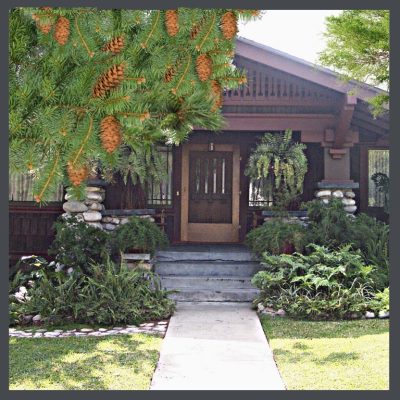 The centered, front-gabled porch is supported by massive timber framing & arroyo stone piers. A free-form arroyo stone chimney is on the east side. Sadly, I have no pictures of my chimney, but you can see it in Jane Powell’s book BUNGALOW DETAILS: Exterior, on page 57. It’s chunky!
The centered, front-gabled porch is supported by massive timber framing & arroyo stone piers. A free-form arroyo stone chimney is on the east side. Sadly, I have no pictures of my chimney, but you can see it in Jane Powell’s book BUNGALOW DETAILS: Exterior, on page 57. It’s chunky!
Typical of Southern California Craftsman style, as one of the earlier houses built, the Hare House helped set the style for later homes in Eagle Rock. Its solid massing & low horizontal profile, is boldly embellished with honest decorative elements, employing simple & natural building materials. As celebrated by the Arts & Crafts Movement, there are many connections from the outside to the inside, with the inviting porch & the sunroom & the many large windows, both casement & doublehung in every room of the house.
The entry features a centered Douglas fir door with 4 beveled lites. We added a screen door (not original) of quartersawn oak with brass screen. You can read about the door & the tiny faces who loved to look out of it here.
The shingle siding was stained when i purchased the house. I hire an inexperienced painter who had slapped a coat of paint on it by the time I arrived home from the office. We had chosen colors together & I thought that he noticed that I was showing him stain samples, but he did not. There is a good chance that he had never stained a house & didn’t know that you could. It broke my heart. I felt like I had betrayed the house.
THE BUILDER OF MY CRAFTSMAN IN EAGLE ROCK
The original owner (through 1923) Rev. Alfred W. Hare & his wife Grace D. Hare made significant contributions to the community of Eagle Rock & the City of Los Angeles.They were both active in the cultural, social & religious life of the town. Local papers of the time feature many stories of their travels, their house guests & their participation in events on behalf of the town’s various social organizations, such as the Women’s Club, the Elks, the Red Cross & the Near East Relief work after the war.
Ordained as a clergyman of the Congregational Church in 1896, Hare moved to Eagle Rock in 1909 as pastor of the shuttered Eagle Rock Congregational Church. Soon after, due to his inspired success of the church, Hare oversaw the construction of a new church building.
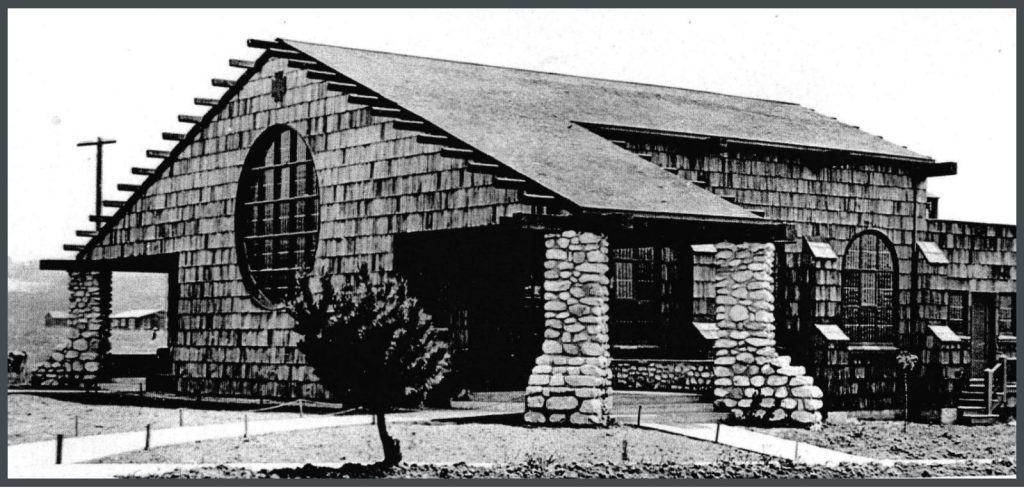
Sadly, this church, an extraordinary example of Arts & Crafts design, is no longer standing. I have been unable to track down both the architect of the house & of the church. To my eye, the house & the church were not drawn by the same hand. I would love to know your opinion of this.
After 1912, he was the pastor at other churches in Los Angeles, notably 27 total years at Park Congregational Church in Angeleno Heights.
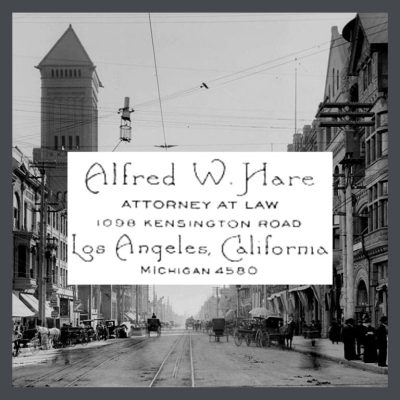 Admitted to the Los Angeles County Bar Association in 1912, Hare founded the large & successful law firm of Hare & Walden situated in downtown Los Angeles, which was connected by trolley to Eagle Rock. The little home office, with its built-in desk & fireplace was probably well-used by Hare, writing sermons, counseling parishioners & then, after he began practicing law, working on cases that he brought home from the office so that he could be with his wife, Grace.
Admitted to the Los Angeles County Bar Association in 1912, Hare founded the large & successful law firm of Hare & Walden situated in downtown Los Angeles, which was connected by trolley to Eagle Rock. The little home office, with its built-in desk & fireplace was probably well-used by Hare, writing sermons, counseling parishioners & then, after he began practicing law, working on cases that he brought home from the office so that he could be with his wife, Grace.
Mrs. Grace Dunsmoor Hare had been a “successful & popular” teacher & was the daughter of Charles Dunsmoor, who was County Clerk of Los Angeles County & California State Bank Commissioner. Both Mr. & Mrs. Hare were revered leaders in the realms of social activism & philanthropy in their community of Eagle Rock.
Learning these things about them helped to explain the house. Though one of the finest homes in the neighborhood, it was situated well away from the grah-ah-ahnd street of the town, Hill Drive. Learning of Reverend Hare’s astute ability to handle money -he helped several churches whose congregations he led to tear up their mortgages- my surmise is that he thriftily chose a less pricey, but large & beautiful lot on which to build.
The house, at 1950 square feet had only 2 bedrooms. In none of my research on him have I seen any evidence of children. In later years Grace was sickly & I wonder if her maladies could have affected her fertility. By the time the house was built, they had been married for 7 years & had probably stopped hoping to grow their family.
 The public areas were clearly designed for entertaining with a large living room & dining room, as well as a sunroom. I can easily imagine gay fundraisers for the Women’s Twentieth Century Club building fund to have taken place there, with Alfred playing the guitar & the 2 of them singing, perhaps accompanied by his sisters who wrote songs & skits to contribute to the effort.
The public areas were clearly designed for entertaining with a large living room & dining room, as well as a sunroom. I can easily imagine gay fundraisers for the Women’s Twentieth Century Club building fund to have taken place there, with Alfred playing the guitar & the 2 of them singing, perhaps accompanied by his sisters who wrote songs & skits to contribute to the effort.
Almost 100 years later, I was a member of Club & participated in fundraising events to restore & preserve the beautiful building. Again, I wonder at the architect because all the members of the Hare family, Alfred, Grace & his 3 sisters were instrumental in the fundraising that enabled it to be built & they possibly would have had some influence in its design.
It was an honor & a privilege to hold the stewardship of this beautiful home. When I restored it, I kept the Hares in mind & strove to create make choices that would please them & create a space in which they would feel comfortable. The woman to whom I sold the house held them in the same regard & the remaining restoration that she performed, was done with the same reverence, for the family, the neighborhood & the period.
TIP: TO READ MORE ABOUT MY LOVE AFFAIR WITH THE HARE HOUSE, CLICK HERE.
 STAY IN THE BUNGALOW KNOW!!!
STAY IN THE BUNGALOW KNOW!!!
Sign up for our newsletter & receive our FREE E-book, 7 VITAL Things to Do Before You Hire a Contractor.
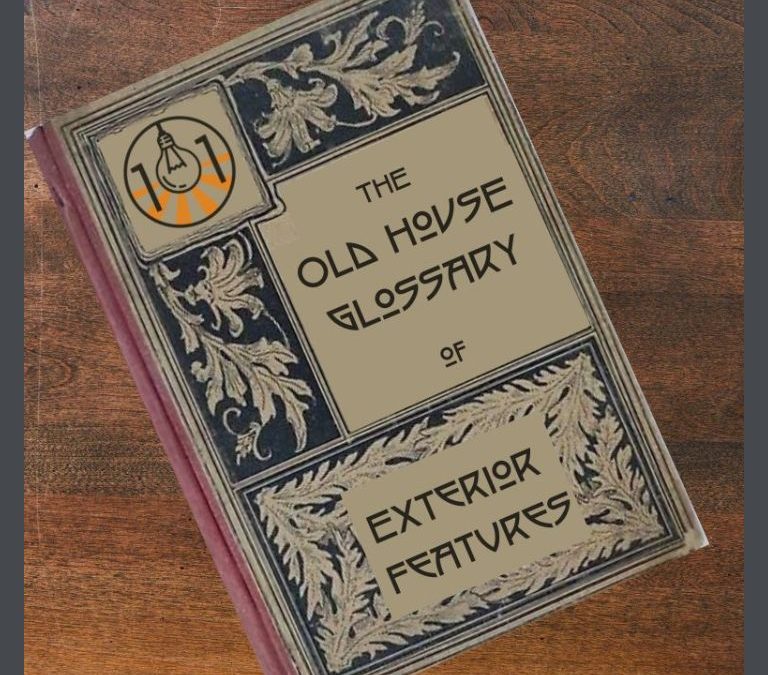
by bungalow101 | Dec 4, 2022 | Features
 This bungalow details exterior glossary will help you get a rapid grasp of what makes a bungalow a bungalow, & not a Mid-Century, a Queen Anne or a Dutch Revival. Many of the terms are applicable to other styles of homes, & some to all periods of architecture & it’s not bad to know them if you love old houses like I do. It’s easier to sing the song if you know all the words. To get really acquainted with all the magic of bungalows, begin at the beginning. Please let me know if you run across any terms in your study of bungalows that are not defined here, or if you should find any of my explanations incomplete or difficult to understand, I’d like to know that too. I studied architecture on my own & would have loved to have had a glossary when I was reading books about it. After stumbling about, I decided to create my own. Regional terms also threw me when I moved from California to Florida.
This bungalow details exterior glossary will help you get a rapid grasp of what makes a bungalow a bungalow, & not a Mid-Century, a Queen Anne or a Dutch Revival. Many of the terms are applicable to other styles of homes, & some to all periods of architecture & it’s not bad to know them if you love old houses like I do. It’s easier to sing the song if you know all the words. To get really acquainted with all the magic of bungalows, begin at the beginning. Please let me know if you run across any terms in your study of bungalows that are not defined here, or if you should find any of my explanations incomplete or difficult to understand, I’d like to know that too. I studied architecture on my own & would have loved to have had a glossary when I was reading books about it. After stumbling about, I decided to create my own. Regional terms also threw me when I moved from California to Florida.
This glossary has been side-checked by Jo-Anne Peck of Historic Shed. Jo-Anne has an undergraduate degree in Building Science, a Masters degree in Historic Preservation & is a certified Florida Building Contractor who has been involved in consulting, design & construction for historic buildings for over 25 years. If a definition needs more than just an image, I’m linking you to my YouTube Channel because I have scooped up some great information on my playlist. Again, alert me to any good ones I may have overlooked. I’m working on a glossary for interior terms & will link it here also when it’s complete.
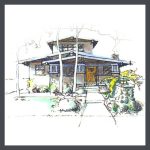
Airplane Bungalow
This type of bungalow features a large, single room on the second floor, generally surrounded completely by windows, designed to be for sleeping in warm weather.
When I go out toodling around shooting bungalows, I look for airplanes because they often have other interesting features.

Bay Window
A window generally, of three wall segments. The two side wall segments are attached to the main wall of the home & project at an angle. A wall section is built parallel with the home’s main wall. Each wall section contains a window (or windows).

Beadboard
Though used inside, eaves & porch ceilings are typically built of beadboard, a tongue & groove paneling with a small beaded groove running along the length. The little indentation or ridge is the “bead.”
Beam
A framing member usually significantly larger than other framing members that carry roof or floor loads over a certain span.
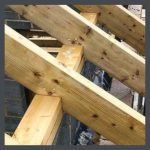
Birdsmouth Joint
A triangular-shaped cut that allows a rafter to sit squarely on the framing.
Bungalow
See this Post

Camber beam
A piece of timber cut archwise. It is much stronger than another of the same size, since being laid with the hollow side downwards, as they usually are, they form a kind of supporting arch.
Casing
Pieces of wood trim surrounding a window or door. It can range from very plain to quite elaborate depending on the home style.
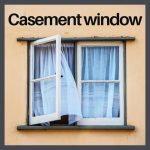
Casement Window
A window that pivots on a side hinge much like a door with a handle to crank the window open.
Character defining features
The visual and physical features that give a building its identity & distinctive character, i.e., why we love bungalows!
Clapboard
Also called bevel siding, lap siding, or weatherboard, depending on the region, clapboard is wide wood siding usually overlapping, installed horizontally to form exterior walls. Why is it called clapboard? The word comes from the Dutch klappen, which means “to split.”

Clinker bricks
Bricks that are produced when wet clay bricks are exposed to excessive heat during the firing process, forming a shiny, dark-colored coating, giving them a blackened appearance. They are usually irregular in shape, often misshapen or split. Clinker bricks are used Arts & Crafts houses to add interest.

Clipped Gable
Or jerkinhead roof (it’s much more fun to say jerkinhead). Instead of ending with a point, it is flattened at the end with a small hip. This feature reduces wind force on facades, probably why you see so many of them in Flor-ee-da.
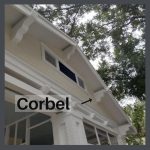
Corbel
A weight-bearing architectural element that projects from the wall & supports a structure above it, especially one that is stepped upward and outward from a vertical surface. They can be used as support or decoratively. Also called an outrigger.

Corner boards
Trim boards placed at the outside corners of a house; most commonly used with wood siding.
Craftsman
An architectural or interior style, inspired by the Arts and Crafts movement, & brought to America by Gustav Stickley. This is a good video that will help you more completely understand what a Craftsman House is.

Dentil
A decorative molding using evenly spaced rectangular blocks. A row of dentils can project from beneath the roof line of a building, in ceilings, furniture & it is also seen in built-ins.

Dormer
A projection of vertical walls through the sloped roof plane with or without a window & its own roof ties into the home’s main roof. Dormers allow the natural light & ventilation to enter into upper floors or attic spaces.
Double-hung window
This is the type of window that you will most see in bungalows. They are composed of 2 sashes, one over the other & are built to slide over one another, each one opening independently. Rather than trying to show or to ‘splain it to you, see can them here, doing their slidy thing, in this great video.
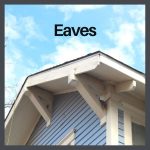
Eaves
The lower part of a roof plane extends outward from the structure at the same slope as the roof & is generally finished with a fascia board. Sometimes referred to as the roof overhang. The eave on a gable end is sometimes referred to as the gable overhang.

Eave brackets
Often triangular in shape, eave brackets are used at the gable ends of a roof to help support the roof overhang. They can be decorative or structural.
Edge Flashing
The metal trim that is placed on the edge of the roof covering the seam between the roof plan on the eave & the fascia board. Sometimes referred to as drip edge.

Fascia
A horizontal board positioned on edge & attached to the ends of the rafters or truss ends where gutters are typically supported. This is called an eave fascia. Fascia placed on the end of a gable roof end is called gable fascia.
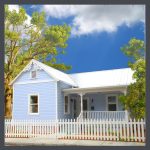
Folk Victorian
A more practical & affordable version of the typical ornate Victorian, seen in the U.S. from around 1890-1910, influencing typical bungalow design.
Footing
A footing supports foundation or bearing walls carrying the weight of upper floors, roof structures, etc. A footing is generally wider than the foundation or bearing wall & is constructed on undisturbed soil to achieve the maximum stability possible. Footings run continuously under all bearing & foundation walls or intermittently under piers.

Gable
A triangular portion of a wall between the edges of intersecting roof pitches, or slopes. A clipped gable has its point “clipped” off.
Gable roof
A pitched roof terminating in a gable at one or both ends.
Gutters
A channel attached to the fascia board designed to carry away water that runs off the roof surface. Read the article about why they are important to maintaining the condition of your foundation.
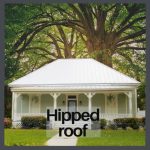
Hipped roof
A roof that slopes in 4 directions, like a pyramid.
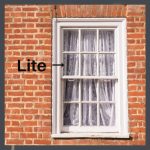
Lites
Separated glass areas in a window, usually separated by some sort of grid pattern.
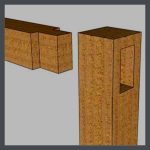
Mortise & tenon
A type of joint used in building structures or furniture that connects two pieces of wood or other material, having two parts, the mortise hole which has a hole & the tenon which has a tongue. The joint may be glued, pinned, or wedged to secure the pieces together. .
This joint is also used with other materials. For example, it is traditionally used by both stonemasons and

Mullion
Vertical pieces of wood that separate 2 windows that sit side-by-side.

Muntins
Vertical & horizontal strips that divide a window’s glass into a grid, or diagonally, into a lattice pattern. They provide stability & support to panes of glass, & were initially used when manufacturers of the past, needed to use several smaller panes to create a large window.
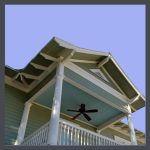
Outrigger
A horizontal brace for the gable eaves. This house in the photo above has 3 outriggers on the front porch gable. Also referred to as a corbel.
Pier foundation
A series of masonry supports that act as the building or porch foundation & allow air flow under the building. Typically used in warmer climates where ground freezing is not an issue. You can read more about foundations here.
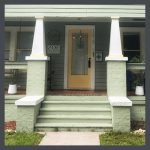
Pony wall
A short wall, typically 3′ in height. The term is often used interchangeably with “knee wall” or “cripple wall.” You can see them on porches & as walls that serve as guards on stairs or balconies.

Porte- cochere
A roofed structure extending from the side of the house, usually from the porch, over the driveway to provide shelter when you are coming from the car into the house.

Portico
A small porch, usually just over the door.

Profile
A shape that is applied to the edge of a piece of wood such as a door or window frame, exterior or interior trim or a window or door jamb. This creates shadow lines and visual interest in the trim piece.
Rabbet
To cut a step-shaped recess along the edge or in the face of a piece of wood, typically forming a match to the edge or lap of another piece.). Here’s a video that explains it perfectly!
Rafter
A framing member, immediately beneath the roofing material extending from the perimeter wall to the ridge of the home. The rafters support the exterior roof surface. They are often left exposed on Craftsman style bungalows.
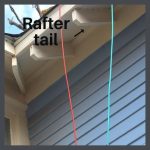
Rafter tail
Portion of a rafter that projects beyond the exterior wall to support the eaves (often cut into decorative designs when left exposed.)
Ridge
The highest part of a roof where the sloped roof planes meet. Sometimes referred to as the roof peak.
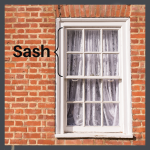
Sash
A window frame. A sash window is made of one or more movable panels or “sashes” that hold panes of glass, which are often separated from other panes (or “lites”) by narrow wood strips (or “muntins.”) A double-hung window has 2 panels or sashes.
Shed Roof
A single sloped roof section which covers an entire area. Structures are often covered by several shed roofs sloping in various directions. Dormers are also often covered with shed roof sections.

Shingles
A small, thin piece of wood, thinner at the top & thicker toward the bottom, that are laid in staggered, overlapping rows as a covering for the roof or sides of a house.
Shotgun house
A narrow house that has a gabled front porch & 2 or more rooms laid out straight behind it. The rooms are connected without hallways. This type of house has doors at each end of it, front & back.
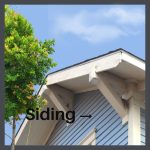
Siding
The exterior material applied to the walls of a house or other building meant to shed water, protect the walls from the effects of weather, insulate, & is key in the aesthetics of the structure.
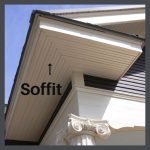
Soffit
The underside area of a building arch, balcony, or an overhanging eave.
Story book
Houses built to look like where Hansel & Gretel & friends could have lived.
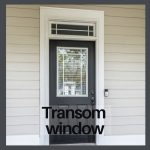
Transom window
A window that is placed above a doorway.
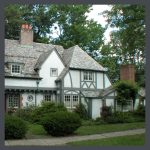
Tudor
Usually stone or a light-color stucco, Tudors feature peaked gables & two-toned exteriors, dressed up with half-timbering.
Window sill
The bottom horizontal trim member at the base of a window projecting outward.
 STAY IN THE BUNGALOW KNOW!!!
STAY IN THE BUNGALOW KNOW!!!
Sign up for our newsletter & receive our FREE E-book, 7 VITAL Things to Do Before You Hire a Contractor.

by bungalow101 | Jul 20, 2022 | Doors & windows, Why Preserve
 I mean really! Why is it such a big honkin’ deal to preserve your bungalow wood windows? If you’re lucky enough to have wood windows in your bungalow that aren’t painted shut, the dang ropes are broken, the wood is rotting & there’s a cracked pane or two. Rain is getting in, maybe it has for some time. Not to mention heat & cold. What’s to preserve?
I mean really! Why is it such a big honkin’ deal to preserve your bungalow wood windows? If you’re lucky enough to have wood windows in your bungalow that aren’t painted shut, the dang ropes are broken, the wood is rotting & there’s a cracked pane or two. Rain is getting in, maybe it has for some time. Not to mention heat & cold. What’s to preserve?
And people are so vehement about it, either way. On the old house FB groups there’s a ridiculous amount of high volume contention coming from both sides. And I don’t believe any claims made about the loose morals of anybody’s mother.
Anyway, it’s so-o-o-o easy to just pick up the phone, call a Big Box store (or one of the window companies that relentlessly pop up on your phone because you have searched for window solutions) & presto, you can get nice new ones installed, maybe even out of a fabulous new, no-maintenance material- vinyl. They provide the product, the labor & a 15-year warranty. With increased R-value. And you can pay with a credit card. Poof! Good-bye to peeling, leaking, moldy windows in your lovely bungalow!
SORRY, BUT HERE’S WHY YOU SHOULD PRESERVE YOUR BUNGALOW WOOD WINDOWS
 The Preservation Brief 17 of the Heritage Preservation Services’ section of the U.S. Department of the Interior, is called, “Architectural Character—Identifying the Visual Aspects of Historic Buildings as an Aid to Preserving their Character.” It provides a process to identify the visual characteristics that give a building its unique style- Dutch Revival, Colonial, Mid-Century or, tah-dah!- a bungalow. It explains how the visual character is most frequently determined by the often-related surface qualities of the materials & craftsmanship. The original choice of materials often plays the dominant role in determining an architectural style.
The Preservation Brief 17 of the Heritage Preservation Services’ section of the U.S. Department of the Interior, is called, “Architectural Character—Identifying the Visual Aspects of Historic Buildings as an Aid to Preserving their Character.” It provides a process to identify the visual characteristics that give a building its unique style- Dutch Revival, Colonial, Mid-Century or, tah-dah!- a bungalow. It explains how the visual character is most frequently determined by the often-related surface qualities of the materials & craftsmanship. The original choice of materials often plays the dominant role in determining an architectural style.
Well, old bungalow wood windows are made of exactly that- wood. An added factor to this is that they are made of old growth wood which is harder, denser & more rot resistant than any windows made today out of farmed, quick-growth wood. They have a particular set of lite patterns & they operate in the same fashion.
But none of this solves your own peeling, leaking, moldy problem so let’s see if I can help.
HOW TO FIND PROFESSIONAL WOOD WINDOW RESTORERS
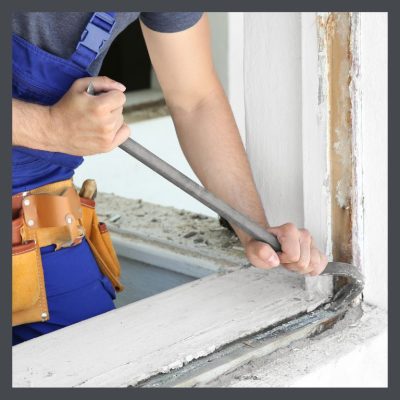 These are some dedicated folk who live their lives in service of old windows. How do you find one? Or for that matter, any tradesperson sensitive to historic materials?
These are some dedicated folk who live their lives in service of old windows. How do you find one? Or for that matter, any tradesperson sensitive to historic materials?
1. Live in an old neighborhood? You probably have a neighborhood association that could offer suggestions. If you don’t know if there is one, your City website can tell you. They usually have neighborhood departments. If you don’t find one, try groups in nearby historic areas.
2. Call your local historic preservation advocacy group. I have a woefully incomplete list of them here, but promise that I am working on expanding it.
3. Call your city preservation office for referrals. If you don’t have one, try county or state.
4. The old stand-by- Google. As with all the ablove sources, it is important to have some knowledge of wood window repair before you start to talking to repair companies. They will appreciate your interest & be better able to help you understand what they will be doing. You’ll be better able to ensure that you get the project that you want.
5. SEE JOHN LEEKE’S BOOK BELOW.
In his book, John Lists over 200 wood window repair pro’s all over the U.S.
DIRECTORY OF WOOD WINDOW PRO’S
 Wood Preservation Alliance
Wood Preservation Alliance
A group formed to help homeowners who wish to save their windows with professionals who can provide the needed services. They also offer great information on window restoration & train the pro’s in further mastering the trade. They have a page in which you can enter your state & find windows professionals. Many of these guys work in more than one state & even those who don’t are not usually opposed to traveling.
These tradespeople tend to be booked far in advance so I would suggest that you contact them even before you have an executed contract on your house. I have included DIY information for you in case you get tired of waiting. I always encourage people to learn about the various trades required to keep an old house in good shape. You’ll get a better project & you will just feel better about old house stewardship.
John Leeke’s book below also includes a directory.
As always, use my tips on hiring a contractor to minimize your risk, as well as your own perceptions, experience & smarts when you choose the people for this task. I don’t know these people & I’m not recommending them, just pointing!
LEARNING HOW REPAIR THE WOOD WINDOWS IN YOUR BUNGALOW
I am not a hands-on preservationist, but I am a maniac researcher, so when I needed to preserve my bungalow wood windows, I got help from the pro’s to teach my carpenter how to do it. So, here’s how you can learn & either DIY or, teach someone else with a greater strength & a higher aptitude for construction & more of a willingness to get dirty.
I strongly recommend that anyone hiring a professional know something about the process so you will experience fewer surprises. It will also help you understand the high price tag of this exacting, multi-step process. Or, you could teach your handy-man!
BOOKS ON HOW TO PRESERVE WOOD WINDOWS
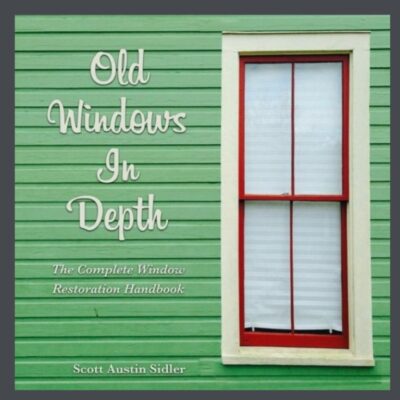 Old Windows In-Depth
Old Windows In-Depth
by Scott Sidler
Scott is a master preservation professional & has written a detailed guide on window restoration. The guide is a clearly written, tutorial showing each tiny step written for the homeowner.
Old Windows In-Depth is nearly 200 pages of picture filled tutorials detailing all of the major information that you’ll need to successfully restore any historic wood or steel window.
The predecessor to this book is the one I used to teach my carpenter how to repair my windows. Scott is very aware of all the little crunchie bits that go into restoring a window that are part of his DNA (Sorry if that’s a weird picture.) but are totally new to us. We didn’t run into any mystery parts or steps that just didn’t work. Learning from Scott’s materials was smooth as silk.
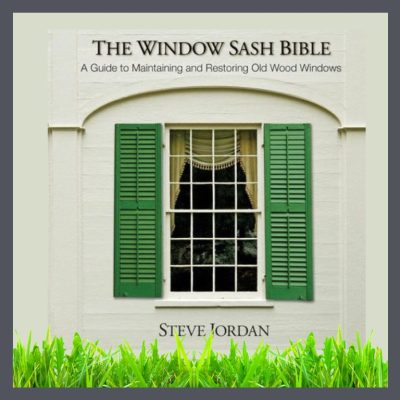 The Window Sash Bible
The Window Sash Bible
by Mr. Steve Jordan
Read this book to learn why most replacements are unnecessary & why your existing windows will serve you better than any replacements.
Whether you are a homeowner hiring tradesmen, or a DIY-er, this book will teach you how to evaluate your windows & plan & execute the needed repairs.
The book introduces you to the history of windows & teaches you about all the pieces & parts so that you can discuss your windows with tradespeople & fully understand what they are telling you about them.
The basics of wood repair are explained in detail from removing sashes, to installing sash cords to, to replacing glass & muntins to weather-sealing.
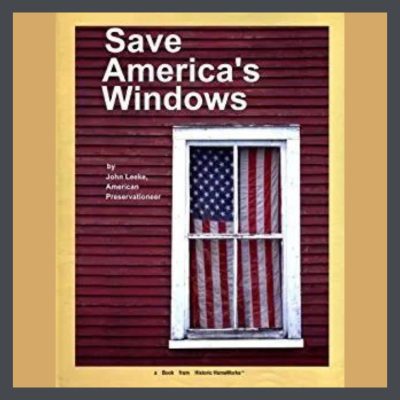 Save America’s Windows
Save America’s Windows
by John Leeke
177 pages, 257 illustrations.
John is the O.G. of wood window repair as well all the other trades related to historic preservation.
This book is the new, 2013 edition which covers the newest in high-tech window materials & techniques in addition to traditional methods. He gives you step-by-step instructions in how to maintain & how to repair old wood windows.
Here’s another cool part: He includes a National directory of 200+ window specialists who know how to repair your windows instead of selling you cheap quality windows that you will have to replace in a decade.
And another: If you follow this link, you can request for him to send you digital downloads that you can you right now.
Dare I add one more? He includes his phone number so that you can order directly from him & ask him any questions plaguing your mind about windows.
You’re welcome.
ON-LINE WOOD WINDOW RESTORATION LEARNING
 The Craftsman Blog
The Craftsman Blog
The Window Course, a step-by-step course to teach you everything you need to successfully restore historic wood windows. You’ll get written posts and dozens of videos for every part of the process. You can see a preview on this page. It shows printed steps & a video demonstrating his tried & true techniques.
Scott offers 3 packages, the most comprehensive of which is about ½ the price of having a window professionally restored. Now, like my own delicate self, you may have an aversion to getting your hands dirty & want to hire someone. You still need to know how to do this! There are many trades for which you will hire people on blind faith & Google reviews, & have no clue whatsoever about the quality of their work. This is not one of those trades. You can learn this & I suggest that you do before you fork over good money to a stranger.
As I mentioned, I used Scott’s book to teach a carpenter how to do this & I learned right along with him. Had Scott offered this video & book package then, I would have bought the ‘spensive one to gain the certainty that would have made the project less overwhelming.
SCHOOLS/WORKSHOPS
Many local preservation organizations offer workshops in wood window restoration. I recommend that you become a member so that you can stay informed of every program that they produce or promote. Follow me on Facebook because I try to announce workshops of various topics there.
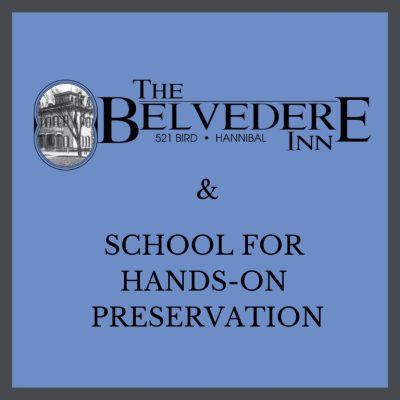 Belvedere School for Hands-On Preservation
Belvedere School for Hands-On Preservation
Hannibal, Missouri
For decades Bob Yapp has delivered hands-on preservation workshops all over the U.S. In 2008 he founded the Belvedere School in Hannibal, Missouri where he trains students to be artisans in the historic preservation trades.
His school is housed in a 5-story. 7,950 square foot 1859 Italianate house which was in deplorable condition when he discovered it. He has used it as a laboratory to teach students hands-on restoration skills. Now that the house is mostly restored, itself is mostly restored, his students now do the hands-on work on their neighbor’s neighbor’s historic houses in the Central Park National Historic District in Hannibal, Missouri.
If you are ready for a totally immersive experience, attend a workshop at whatever level of physicality suits you. Stay at his wife’s bed & breakfast in the restored house, play billiards in the parlor & fortify yourself for the workshop day with a delightful homemade breakfast.
Craftwork Training Center
History Reveals Methods and Materials which are Lasting.
We Teach using Knowledge, Time, and Practice to perfect your art.
Telford, Pennsylvania
Hosted by LimeWorks, a masonry material manufacturer, Craftwork Training Center holds training workshops throughout the year to teach people to properly use their products & to understand proper architectural restoration of masonry- plaster repair, repointing brick & stone, surface repair.
They also have workshops that teach the skills needed to restore & repair wood windows.
Their objective is to educate people so that they can enter the trades as professional & earn a good living, however, their classes are appropriate for a homeowner. Give them a ring to find out if any particular classes would be right for your skill level.
 YOUTUBE
YOUTUBE
I have saved some great videos to my channel, many of them made by the experts mentioned about. This is a great way to get oriented to the subject of wood window repair. Watch several of them! Paired with a book, you’ll earn your degree in wood window repair.
I also have many videos on many preservation subjects, each one teaching you more about your bungalow, it’s history, its construction, its possibilities.
BACK TO YOUR BUNGALOW WOOD WINDOWS
Yes, I think that you ought to restore them. If they are past the point of no return, you can build new ones using old growth lumber which is harder, denser & resists rot to a greater degree than quick growth, farmed, newly harvested wood. You can generally get this wood from a local salvage yard & have it milled into window pieces that you or your handy carpenter can join yourselves. Carefully save the glass from the old windows to install into the new frames. Both you & the kitties will enjoy that wavy glass view into the garden.
TIP: TO FIND OUT MORE ABOUT OLD GROWTH WOOD, WATCH SOME GREAT VIDEOS HERE.
 STAY IN THE BUNGALOW KNOW!!!
STAY IN THE BUNGALOW KNOW!!!
Sign up for our newsletter & receive our FREE E-book, 7 VITAL Things to Do Before You Hire a Contractor.

 There are a lot of styles with crossover elements that can make them confusing to classify (and sometimes make architectural historians argue). Craftsman (1905-1930) and Tudor Revival (1890-1940) are two house styles that were popular around the same time period in the U.S., and you see elements of each in many homes since both styles “express the structure” in their design.
There are a lot of styles with crossover elements that can make them confusing to classify (and sometimes make architectural historians argue). Craftsman (1905-1930) and Tudor Revival (1890-1940) are two house styles that were popular around the same time period in the U.S., and you see elements of each in many homes since both styles “express the structure” in their design.




![]()
 This article was written by Jo-Anne Peck of Preservation Resource, Inc. & Historic Shed. Jo-Anne is a historic preservation professional with a degree in Building Science, a Master’s of Fine Arts in Historic Preservation & a licensed Florida Building Contractor with over 25 years experience in preservation. She has kindly provided these photos & this information based her vast knowledge of bungalows.
This article was written by Jo-Anne Peck of Preservation Resource, Inc. & Historic Shed. Jo-Anne is a historic preservation professional with a degree in Building Science, a Master’s of Fine Arts in Historic Preservation & a licensed Florida Building Contractor with over 25 years experience in preservation. She has kindly provided these photos & this information based her vast knowledge of bungalows. STAY IN THE BUNGALOW KNOW!!! Sign up for our newsletter & receive our FREE E-book, 7 VITAL Things to Do Before You Hire a Contractor.
STAY IN THE BUNGALOW KNOW!!! Sign up for our newsletter & receive our FREE E-book, 7 VITAL Things to Do Before You Hire a Contractor.


 Let’s break down some bungalow characteristics to better understand what makes a bungalow, a bungalow. Character defining features, as further explained in the Secretary of the Interior’s
Let’s break down some bungalow characteristics to better understand what makes a bungalow, a bungalow. Character defining features, as further explained in the Secretary of the Interior’s 







 From their framing to their siding to their doors & windows to their built-ins & their flooring, our old houses, are built of old growth wood. Thousands of board feet of it.
From their framing to their siding to their doors & windows to their built-ins & their flooring, our old houses, are built of old growth wood. Thousands of board feet of it. Let’s start with the Redwood, one class being the oldest plants on earth, living from about 800 to 3,200 years. On the west coast, before they were chopped to build our houses, they played an important part in the lives of early indigenous peoples who revered them, building structures from fallen trees. Native elder Minnie Reeves called them “a special gift from the Great Creator. Destroy these trees and you destroy the Creator’s love . . . and you will eventually destroy mankind.”
Let’s start with the Redwood, one class being the oldest plants on earth, living from about 800 to 3,200 years. On the west coast, before they were chopped to build our houses, they played an important part in the lives of early indigenous peoples who revered them, building structures from fallen trees. Native elder Minnie Reeves called them “a special gift from the Great Creator. Destroy these trees and you destroy the Creator’s love . . . and you will eventually destroy mankind.” The Domesday Book of 1086, a survey ordered by William the Conqueror to record his holdings, indicated a forest cover of 15%, By the start of the next millennium, this coverage had dropped to 5%.
The Domesday Book of 1086, a survey ordered by William the Conqueror to record his holdings, indicated a forest cover of 15%, By the start of the next millennium, this coverage had dropped to 5%.  Trees are planted in man-made forests with the purpose of generating a large amount of product, fast. These farms do not replicate the ecology of the natural forest. Generally they are one species only, & all the trees are planted at the same time. The trees are planted in rows spaced to allow maximum sunlight & water exposure so they grow very fast. The old forests allowed trees to grow slowly, putting on more tightly-packed growth rings
Trees are planted in man-made forests with the purpose of generating a large amount of product, fast. These farms do not replicate the ecology of the natural forest. Generally they are one species only, & all the trees are planted at the same time. The trees are planted in rows spaced to allow maximum sunlight & water exposure so they grow very fast. The old forests allowed trees to grow slowly, putting on more tightly-packed growth rings Much of this mutual adaptation involves microorganisms, the fungi that break down the fiber of the dead trees & turn them into nutritious soil, but also form a communication network for the trees. Watch this short
Much of this mutual adaptation involves microorganisms, the fungi that break down the fiber of the dead trees & turn them into nutritious soil, but also form a communication network for the trees. Watch this short 
 The
The  I also used the same rocks to form a path from the driveway to the front walk. I installed baby’s tears (Soleirolia soleirolii) a mossy appearing tropical perennial with tiny, tiny leaves between the path & the border. They were very soft & sweet & I coaxed them to grow so that they would provide a natural woodland look. A week before my mother was supposed to arrive to see the house for the first time, my gardener edged them so they were level on top & flat against the border. I am a plant whisperer but I admit that during that week I was more of a plant cheerleader & probably even a plant sergeant, alternating cheering & commanding them to grow back into gentle, fluffy mounds before my mom’s arrival.
I also used the same rocks to form a path from the driveway to the front walk. I installed baby’s tears (Soleirolia soleirolii) a mossy appearing tropical perennial with tiny, tiny leaves between the path & the border. They were very soft & sweet & I coaxed them to grow so that they would provide a natural woodland look. A week before my mother was supposed to arrive to see the house for the first time, my gardener edged them so they were level on top & flat against the border. I am a plant whisperer but I admit that during that week I was more of a plant cheerleader & probably even a plant sergeant, alternating cheering & commanding them to grow back into gentle, fluffy mounds before my mom’s arrival. The centered, front-gabled porch is supported by massive timber framing & arroyo stone piers. A free-form arroyo stone chimney is on the east side. Sadly, I have no pictures of my chimney, but you can see it in Jane Powell’s book BUNGALOW DETAILS: Exterior, on page 57. It’s chunky!
The centered, front-gabled porch is supported by massive timber framing & arroyo stone piers. A free-form arroyo stone chimney is on the east side. Sadly, I have no pictures of my chimney, but you can see it in Jane Powell’s book BUNGALOW DETAILS: Exterior, on page 57. It’s chunky!
 Admitted to the Los Angeles County Bar Association in 1912, Hare founded the large & successful law firm of Hare & Walden situated in downtown Los Angeles, which was connected by trolley to Eagle Rock. The little home office, with its built-in desk & fireplace was probably well-used by Hare, writing sermons, counseling parishioners & then, after he began practicing law, working on cases that he brought home from the office so that he could be with his wife, Grace.
Admitted to the Los Angeles County Bar Association in 1912, Hare founded the large & successful law firm of Hare & Walden situated in downtown Los Angeles, which was connected by trolley to Eagle Rock. The little home office, with its built-in desk & fireplace was probably well-used by Hare, writing sermons, counseling parishioners & then, after he began practicing law, working on cases that he brought home from the office so that he could be with his wife, Grace. The public areas were clearly designed for entertaining with a large living room & dining room, as well as a sunroom. I can easily imagine gay fundraisers for the
The public areas were clearly designed for entertaining with a large living room & dining room, as well as a sunroom. I can easily imagine gay fundraisers for the 
 This bungalow details
This bungalow details 


































 I mean really! Why is it such a big honkin’ deal to preserve your bungalow wood windows? If you’re lucky enough to have wood windows in your bungalow that aren’t painted shut, the dang ropes are broken, the wood is rotting & there’s a cracked pane or two. Rain is getting in, maybe it has for some time. Not to mention heat & cold. What’s to preserve?
I mean really! Why is it such a big honkin’ deal to preserve your bungalow wood windows? If you’re lucky enough to have wood windows in your bungalow that aren’t painted shut, the dang ropes are broken, the wood is rotting & there’s a cracked pane or two. Rain is getting in, maybe it has for some time. Not to mention heat & cold. What’s to preserve? The
The  These are some dedicated folk who live their lives in service of old windows. How do you find one? Or for that matter, any tradesperson sensitive to historic materials?
These are some dedicated folk who live their lives in service of old windows. How do you find one? Or for that matter, any tradesperson sensitive to historic materials?






 YOUTUBE
YOUTUBE